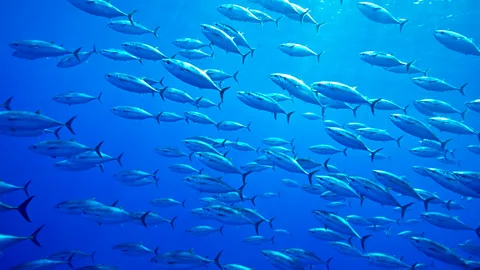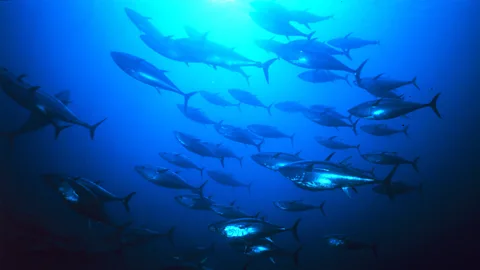 Getty Images
Getty ImagesOnce pushed to the brink of extinction by overfishing, bluefin tuna has experienced a spectacular rebound in recent years. But can it survive the onslaught of climate change?
Tuna is the most commercially valuable family of fish in the entire world and bluefin, typically used in sushi and sashimi, is the most expensive, says Sarah Glaser, senior director of the oceans futures team at the World Wide Fund for Nature (WWF) US. A single bluefin fetches more than a tonne of skipjack, the smallest and most abundant tuna species. This high value has led to overfishing, with huge global demand for sushi severely depleting bluefin stocks, pushing the species to the brink of extinction in 2010.
The three bluefin tuna species
• Atlantic bluefin feed in waters off the coast of North America, Europe and Africa. They spawn in the Gulf of Mexico and Mediterranean Sea.
• Pacific bluefin spawn in the Western Pacific Ocean and migrate more than 5,000 miles (8,000km) to feed off the Californian coast.
• Southern bluefin feed in the temperate waters around Australia and migrate to the waters southeast of Java to spawn.
“It’s a big success story. We managed to reverse this trend of overfishing and near stock collapse in less than 20 years,” says Alessandro Buzzi, WWF’s fisheries project manager who specialises in tuna fishing. “We are now in a situation where overfishing is not a threat anymore.”
But bluefin tuna now face another major challenge: climate change. Studies show that bluefin tuna are highly sensitive to temperature changes, with small increases affecting their metabolism, breeding and feeding habits. Scientists warn that these changes to bluefin tuna could in turn impact other marine wildlife as well as fishing communities.
Moving north
As ocean temperatures rise, bluefin tuna are moving to colder waters.
Irish scientists found that in 2019, six giant Atlantic bluefin peeled away from their established migration routes between Ireland and the Bay of Biscay or the Mid-Atlantic Ridge, to move further north towards Iceland. The new route was thought to be in response to a marine heatwave.
“We are seeing bluefin tuna feeding in unusual areas, for example in the North Sea, around Scandinavia and Iceland,” says Buzzi. “We are already seeing changes in migration patterns.”
There are also concerns about the impact rising temperatures will have on spawning grounds, says Buzzi. In June and July, Atlantic bluefin flock to the Mediterranean to spawn, helping make the Mediterranean Sea the most important bluefin tuna fishery in the world.
Rising temperatures may drive juvenile bluefin out of the Mediterranean within the next 50 years, according to a study by the University of Southampton in the UK. The study found that marine temperatures exceeding 28C (82F) adversely impact the metabolism and growth of juvenile bluefin tuna.
To discover this critical temperature threshold, Clive Trueman, professor of geochemical ecology at the University of Southampton, developed a pioneering method which analysed the metabolism of bluefin tuna via their ears. Specifically, Trueman and his team looked at a feature called an otolith – a calcium carbonate structure in the inner ear of fish, which enables them to balance, and perceive noise and vibrations.
Similar to tree rings, otoliths reveal a fish’s age and contain isotopes which disclose its past environmental conditions, says Trueman. The oxygen isotopes reveal the water temperature the fish experienced while alive, while the carbon isotopes indicate how quickly it converted food into energy, namely its metabolism, he says.
“Those two things together give us the temperature at which the fish was living and its metabolic rate,” says Trueman. The level of detail these bones revealed about the fish’s conditions was unprecedented. “It’s astounding. It’s basically like having a smart watch.”
Bluefin need warm water to spawn – their eggs develop when temperatures reach 20C (68F) – but if the water warms past a certain threshold then their metabolism starts to decline, Trueman says. “That threshold is 28C [82F].”
The temperature in the Mediterranean Sea exceeded this critical threshold in August 2024, when the daily median surface temperature reached a record-breaking 28.45C (83.21F). According to Trueman, studies show that bluefin tuna spend most of their time in the upper 20m (65.6ft) of the water column. “So it’s likely that surface water temperatures are really critical for juvenile (less than one-year-old) tuna in the Mediterranean,” he says.
 Getty Images
Getty ImagesAs ocean temperatures increase, bluefin tuna are expected to move their nursery areas away from the Mediterranean into cooler waters, potentially into the Bay of Biscay, says Trueman. “If the juveniles’ habitat does start to shift, then the places they are forced to [migrate to] are places with other traditional fisheries,” he adds.
The concern is that juvenile tuna might end up as bycatch in established anchovy and sardine fisheries in the Bay of Biscay, he says. “You need to think about how you might change your monitoring or change your fishing regulations to adapt to those changing distributions.”
Saving bluefin
Changing migration patterns will also affect the fishing communities who depend on catching tuna for their livelihood, says Buzzi. “In the Mediterranean, a lot of fishing communities have historically depended on tuna passing by their part of the coast at a certain time of year. The tuna traps work based on these migrations. If climate change alters the migrating patterns, this cannot be a reliable system anymore.”
“[These communities] don’t see the ocean temperatures changing and the ecological models. What they see is that they have to go further to catch fish,” says Glaser. “They see that the fish are moving, that they are changing their migration habits.”
Smaller fishing communities are already impacted by strict measures which were introduced to prevent overfishing of bluefin over the past two decades, says Buzzi. In the early 2000s, “there used to be hundreds of boats catching bluefin tuna in Italy…there were no rules,” he says. “It was possible to catch bluefin tuna with no restrictions, at any age, even before they reached sexual maturity.”
The strict new fishing quotas have led to the collapse of a lot of the bluefin fishing industry, says Buzzi. “Now just 12 [boats] are allowed to catch bluefin,” he says. This tightly regulated quota system favours bigger boats, with observers on board, rather than smaller harvesters, he says. Although the restrictions may have helped bolster fish stocks, the needs of smaller fishing communities haven’t always been prioritised. “This is the next challenge that needs addressing.”
 Getty Images
Getty ImagesWhile bluefin populations have rebounded in recent years, “the risk of extinction has sadly never gone away”, says Glaser.
“If we manage to change our policies and regulations and make fisheries much more sustainable, a lot of fish will be able to adapt to climate change,” she says. But this is more difficult for long-lived species such as bluefin, which don’t spawn until they are about eight, than small pelagic fish like sardines and anchovies. These smaller fish reproduce very quickly, so their populations are better able to respond to changes in temperatures, she adds.
“We are on a path to recovery,” Trueman says. “We’ve just got to make sure that this isn’t scuppered by the next problem down the line. Other problems are looming.”
Glaser says that the global effort to save bluefin tuna is not lost. “I would cautiously say we’re seeing important scientific improvements in bluefin tuna stocks around the world,” she says. “And that gives me hope.”
